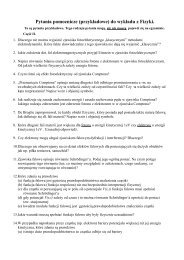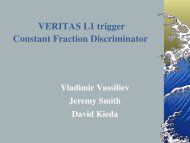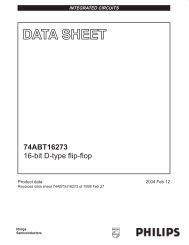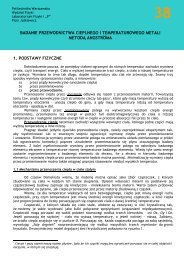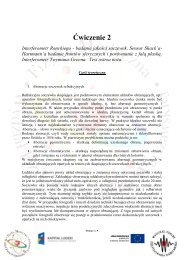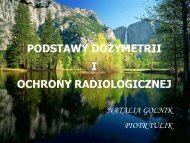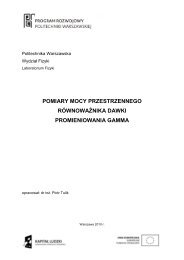Surprising features of ultra cold atomic gases at BCS-BEC crossover
Surprising features of ultra cold atomic gases at BCS-BEC crossover
Surprising features of ultra cold atomic gases at BCS-BEC crossover
You also want an ePaper? Increase the reach of your titles
YUMPU automatically turns print PDFs into web optimized ePapers that Google loves.
<strong>Surprising</strong> <strong>fe<strong>at</strong>ures</strong> <strong>of</strong> <strong>ultra</strong> <strong>cold</strong><br />
<strong><strong>at</strong>omic</strong> <strong>gases</strong> <strong>at</strong> <strong>BCS</strong>-<strong>BEC</strong> <strong>crossover</strong>
<strong>Surprising</strong> <strong>fe<strong>at</strong>ures</strong> <strong>of</strong> <strong>ultra</strong><strong>cold</strong><br />
<strong><strong>at</strong>omic</strong> <strong>gases</strong> <strong>at</strong> <strong>BCS</strong>-<strong>BEC</strong> <strong>crossover</strong><br />
Piotr Magierski (Warsaw University <strong>of</strong> Technology/<br />
University <strong>of</strong> Washington, Se<strong>at</strong>tle)<br />
Collabor<strong>at</strong>ors: Aurel Bulgac<br />
Joaquin E. Drut<br />
Yuan Lung (Alan) Luo<br />
Kenneth J. Roche<br />
Gabriel Wlazłowski<br />
Yongle Yu<br />
(Se<strong>at</strong>tle)<br />
(Se<strong>at</strong>tle OSU LANL)<br />
(Se<strong>at</strong>tle)<br />
(PNNL/Se<strong>at</strong>tle)<br />
(Warsaw)<br />
(Se<strong>at</strong>tle Lund Wuhan)
Outline<br />
<strong>BCS</strong>-<strong>BEC</strong> <strong>crossover</strong>. Universality <strong>of</strong> the unitary u<br />
regime.<br />
Physical realiz<strong>at</strong>ion <strong>of</strong> the unitary regime: <strong>ultra</strong> <strong>cold</strong> <strong><strong>at</strong>omic</strong><br />
<strong>gases</strong>.<br />
Equ<strong>at</strong>ion <strong>of</strong> st<strong>at</strong>e for the uniform Fermi gas in the unitary<br />
regime. Critical temper<strong>at</strong>ure. Experiment vs. Theory.<br />
Unitary Fermi gas as a high-Tc superconductor: pseudogap<br />
phase<br />
Nonequilibrium phenomena: gener<strong>at</strong>ion and dynamics <strong>of</strong><br />
superfluid vortices.
Sc<strong>at</strong>tering <strong>at</strong> low energies<br />
(s-wave sc<strong>at</strong>tering)<br />
If<br />
ψ<br />
2π<br />
λ = > > R<br />
k<br />
R - radius <strong>of</strong> the interaction potential<br />
<br />
ikr<br />
ik⋅r<br />
e<br />
( r) = e + f ( k) ; f ( k) - sc<strong>at</strong>tering amplitude<br />
r<br />
k → 0<br />
1<br />
f ( k) = , a - sc<strong>at</strong>tering length, r 0 - effective range<br />
1 1 2<br />
− ik − + r0<br />
k<br />
a 2<br />
k → 0 then the interaction is determined by the sc<strong>at</strong>tering length alone.
Wh<strong>at</strong> is a unitary gas?<br />
A gas <strong>of</strong> interacting fermions is in the unitary regime if the average<br />
separ<strong>at</strong>ion between particles is large compared to their size (range <strong>of</strong><br />
interaction), but small compared to their sc<strong>at</strong>tering length.<br />
n r 3<br />
1 0<br />
n |a| 3 1<br />
n - particle density<br />
a - sc<strong>at</strong>tering length<br />
r 0<br />
- effective range<br />
NONPERTURBATIVE<br />
REGIME<br />
System is dilute but<br />
strongly interacting!
Thermodynamics <strong>of</strong> the unitary Fermi gas
Expected phases <strong>of</strong> a two species dilute Fermi system<br />
<strong>BCS</strong>-<strong>BEC</strong> <strong>crossover</strong><br />
Characteristic temper<strong>at</strong>ure:<br />
T C<br />
superfluid-normal<br />
phase transition<br />
T<br />
Strong interaction<br />
UNITARY REGIME<br />
Characteristic temper<strong>at</strong>ures:<br />
T C<br />
T<br />
T<br />
∗<br />
∗<br />
superfluid-normal<br />
phase transition<br />
break up <strong>of</strong> Bose molecule<br />
><br />
T<br />
c<br />
weak interaction<br />
<strong>BCS</strong> Superfluid<br />
?<br />
weak interactions<br />
Molecular <strong>BEC</strong> and<br />
Atomic+Molecular<br />
Superfluids<br />
1/a<br />
a0<br />
shallow 2-body bound st<strong>at</strong>e<br />
Bose<br />
molecule
Bertsch’s Many-Body X<br />
challenge, Se<strong>at</strong>tle, 1999<br />
Wh<strong>at</strong> are the ground st<strong>at</strong>e properties <strong>of</strong> the many-body system<br />
composed <strong>of</strong> spin ½ fermions interacting via a zero-range, infinite<br />
sc<strong>at</strong>tering-length contact interaction.<br />
Why? Besides pure theoretical curiosity, this problem is relevant to neutron stars!<br />
In 1999 it was not yet clear, either theoretically or experimentally,<br />
whether such fermion m<strong>at</strong>ter is stable or not! A number <strong>of</strong> people argued th<strong>at</strong><br />
under such conditions Fermionic m<strong>at</strong>ter is unstable.<br />
- systems <strong>of</strong> bosons are unstable<br />
- systems <strong>of</strong> three or more fermion species are unstable<br />
•<br />
Baker (LANL, winner <strong>of</strong> the MBX challenge) concluded th<strong>at</strong> the system is stable. See<br />
also Heiselberg (entry to the same competition)<br />
•<br />
Carlson et al (2003) Fixed-Node Green Function Monte Carlo<br />
and Astrakharchik et al (2004) FN-DMC provided the best theoretical<br />
estim<strong>at</strong>es for the ground st<strong>at</strong>e energy <strong>of</strong> such systems.<br />
Carlson et al (2003) have also shown th<strong>at</strong> the system has a huge pairing gap !<br />
•<br />
Thomas’ Duke group (2002) demonstr<strong>at</strong>ed experimentally th<strong>at</strong> such systems<br />
are (meta)stable.<br />
3<br />
Egs = ε<br />
F<br />
N × ξ ∆ = ε<br />
F<br />
× ς<br />
5<br />
ξ = 0.40(1), ζ = 0.50(1)
One fermionic <strong>at</strong>om in magnetic field<br />
F m F<br />
<br />
F = I + J ; J = L + S<br />
Nuclear spin<br />
Electronic spin<br />
Two hypefine st<strong>at</strong>es are<br />
popul<strong>at</strong>ed in the trap<br />
Collision <strong>of</strong> two <strong>at</strong>oms: At low energies (low density <strong>of</strong> <strong>at</strong>oms) only L=0<br />
(s-wave) sc<strong>at</strong>tering is effective.<br />
• Due to the high diluteness <strong>at</strong>oms in the same hyperfine<br />
st<strong>at</strong>e do not interact with one another.<br />
• Atoms in different hyperfine st<strong>at</strong>es experience interactions<br />
only in s-wave.
Effective Hamiltonian <strong>of</strong> an <strong>at</strong>om-<strong>at</strong>om system<br />
∆<br />
E<br />
Z<br />
V = ( γ J − γ I ) B<br />
e z n z
One open channel with one resonant bound st<strong>at</strong>e<br />
(s-wave sc<strong>at</strong>tering)
Evidence for fermionic<br />
superfluidity: vortices!<br />
system <strong>of</strong> fermionic<br />
6<br />
Li<br />
<strong>at</strong>oms<br />
Feshbach resonance:<br />
B=834G<br />
<strong>BEC</strong> side:<br />
a>0<br />
UNITARY REGIME<br />
<strong>BCS</strong> side:<br />
a
Superconductivity and superfluidity<br />
in Fermi systems<br />
20 orders <strong>of</strong> magnitude over a century <strong>of</strong> (low temper<strong>at</strong>ure) physics<br />
Dilute <strong><strong>at</strong>omic</strong> Fermi <strong>gases</strong><br />
T c<br />
10<br />
-12 – 10 -9 eV<br />
Liquid 3 He T c 10<br />
10 -7<br />
eV<br />
-7 eV<br />
Metals, composite m<strong>at</strong>erials<br />
Nuclei, neutron stars<br />
• QCD color superconductivity<br />
T c<br />
10<br />
-3 – 10 -2 eV<br />
T c<br />
10<br />
5 – 10 6 eV<br />
T c<br />
10<br />
7 – 10 8 eV<br />
units (1 eV 10 4 K)
a = ±∞<br />
Devi<strong>at</strong>ion from Normal Fermi Gas<br />
Normal Fermi Gas<br />
(with vertical <strong>of</strong>fset, solid line)<br />
Bogoliubov-Anderson phonons<br />
and quasiparticle contribution<br />
(dashed<br />
line )<br />
Bogoliubov-Anderson phonons<br />
contribution only (dotted(<br />
line)<br />
Quasi-particle contribution only<br />
(dotted<br />
line)
ς =e<br />
− µ β<br />
h(1, ς ) / 2 = P( µ , T ) / (2 P ( µ ,T))<br />
P ( µ ,T) - pressure <strong>of</strong> a single<br />
1<br />
component <strong>of</strong> the noninteracting<br />
Fermi gas<br />
1<br />
S. Nascimbene et al. N<strong>at</strong>ure 463, 1057 (2010)<br />
From a talk given by C. Salomon, June 2nd, 2010, Saclay
Comparison with experiment<br />
John Thomas’ group <strong>at</strong> Duke University,<br />
L.Luo, et al. Phys. Rev. Lett. 98, 080402, (2007)<br />
THEORY<br />
EXP.<br />
THEORY<br />
E<br />
0<br />
=<br />
Nε<br />
ho<br />
F<br />
Entropy as a function <strong>of</strong> energy (rel<strong>at</strong>ive to the ground st<strong>at</strong>e)<br />
for the unitary Fermi gas in the harmonic trap.<br />
Theory:<br />
R<strong>at</strong>io <strong>of</strong> the mean square cloud size <strong>at</strong> B=1200G to<br />
its value <strong>at</strong> unitarity (B=840G) as a function <strong>of</strong><br />
the energy. Experimental d<strong>at</strong>a are denoted<br />
by point with error bars.<br />
B = 1200G ? 1/ k a ≈ − 0.75<br />
F
Superfluidity in <strong>ultra</strong> <strong>cold</strong> <strong><strong>at</strong>omic</strong> gas<br />
Eagles (1960), Leggett (1980), Nozieres and Schmitt-Rink (1985),<br />
Randeria et al. (1993),…<br />
If a > 1<br />
2m<br />
T<br />
∆<br />
If |a|=∞ and nr 03<br />
>r 0<br />
) and na 3
Results in the vicinity<br />
<strong>of</strong> the unitary limit:<br />
-Critical temper<strong>at</strong>ure<br />
-Pairing gap <strong>at</strong> T=0<br />
Note th<strong>at</strong><br />
- <strong>at</strong> unitarity:<br />
- for <strong><strong>at</strong>omic</strong> nucleus:<br />
<strong>BCS</strong> theory predicts:<br />
∆ ( T = 0) T C ≈ 1.7<br />
At unitarity:<br />
∆ ( T = 0) T C ≈ 3.3<br />
∆<br />
∆<br />
/ ε ≈ 0.5<br />
F<br />
/ ε ≈ 0.03<br />
This is NOT a <strong>BCS</strong> superfluid!<br />
F<br />
Bulgac, Drut, Magierski, PRA78, 023625(2008)
N<strong>at</strong>ure <strong>of</strong> the superfluid-normal phase transition in the vicinity<br />
<strong>of</strong> the unitary regime
Pairing gap and pseudogap<br />
Outside the <strong>BCS</strong> regime close to the unitary limit, but still before <strong>BEC</strong>,<br />
superconductivity/superfluidity emerge out <strong>of</strong> a very exotic, non-Fermi<br />
liquid normal st<strong>at</strong>e<br />
pseudogap<br />
order parameter<br />
T<br />
C<br />
=<br />
0.15(1) ε<br />
F<br />
T<br />
*<br />
Monte Carlo calcul<strong>at</strong>ions<br />
<strong>at</strong> the unitary regime<br />
The onset <strong>of</strong> superconductivity occurs<br />
in the presence <strong>of</strong> fermionic pairs!
Gap in the single particle fermionic spectrum from MC calcs.<br />
Normal Fermi gas<br />
[ε ]<br />
F<br />
Crossover region<br />
Monte Carlo<br />
uncertainties<br />
Pseudogap phase<br />
Noncondensed bosons + fermions<br />
Tc<br />
Superfluid phase<br />
Paired fermions<br />
Condensed bosons<br />
F<br />
P. Magierski, G. Wlazłowski, A.Bulgac to be published
Unitary Fermi gas as a high-Tc superconductor<br />
The situ<strong>at</strong>ion in the <strong>ultra</strong><strong>cold</strong> <strong><strong>at</strong>omic</strong> <strong>gases</strong> is somewh<strong>at</strong> similar to this<br />
encountered in high-temper<strong>at</strong>ure superconductors.<br />
Despite <strong>of</strong> crucial differences between these two physical systems it seems<br />
as they share <strong>at</strong> least one common fe<strong>at</strong>ure - the presence <strong>of</strong> the pseudogap<br />
phase.<br />
Fermions are correl<strong>at</strong>ed but the long range is lost
Gener<strong>at</strong>ion and dynamics <strong>of</strong> superfluid vortices <strong>of</strong> exotic topologies
Density cut through a stirred unitary Fermi gas <strong>at</strong> various times.
Pr<strong>of</strong>ile <strong>of</strong> the pairing gap <strong>of</strong> a stirred unitary Fermi gas <strong>at</strong> various times.
Exotic vortex topologies: dynamics <strong>of</strong> vortex rings<br />
Heavy spherical object moving through the superfluid unitary Fermi gas
Applic<strong>at</strong>ions to unitary gas and nuclei and how all this was<br />
implemented on JaguarPf (the largest supercomputer in the world)


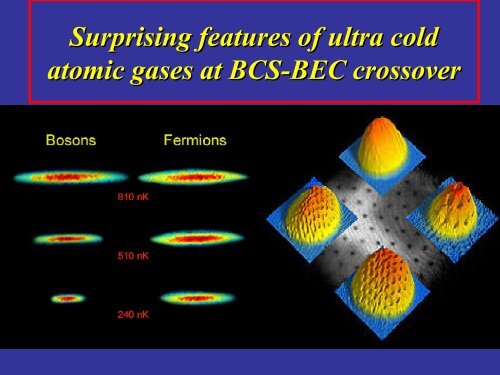

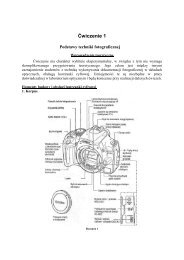
![WykÅad 10 [tryb zgodnoÅci]](https://img.yumpu.com/48543051/1/190x134/wykaad-10-tryb-zgodnoaci.jpg?quality=85)

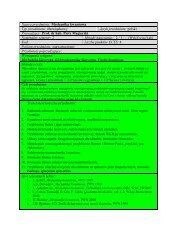
![WykÅad 1 [tryb zgodnoÅci]](https://img.yumpu.com/46941442/1/190x134/wykaad-1-tryb-zgodnoaci.jpg?quality=85)
